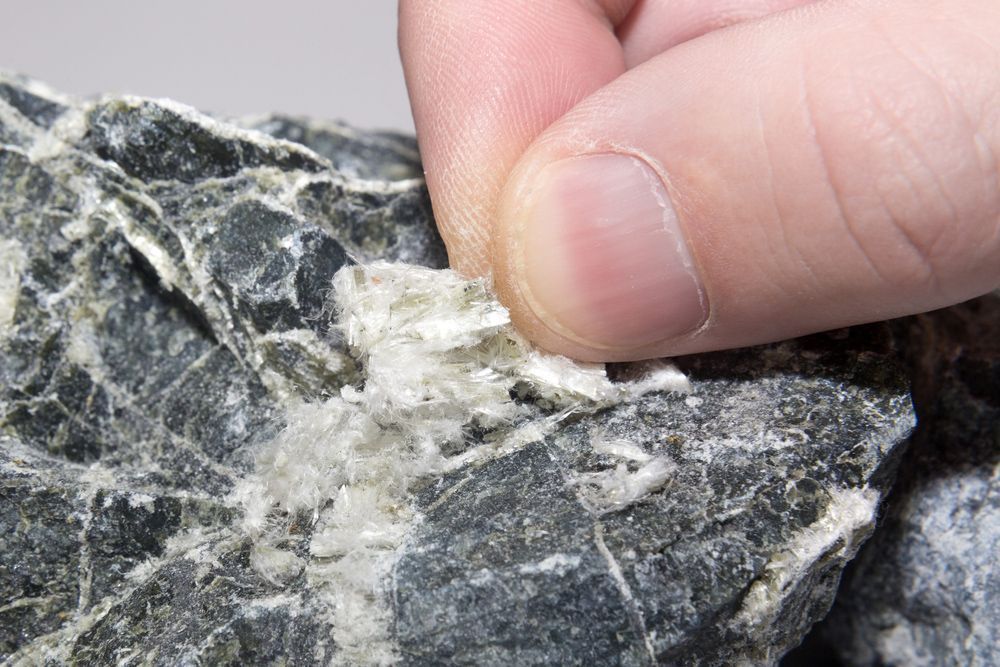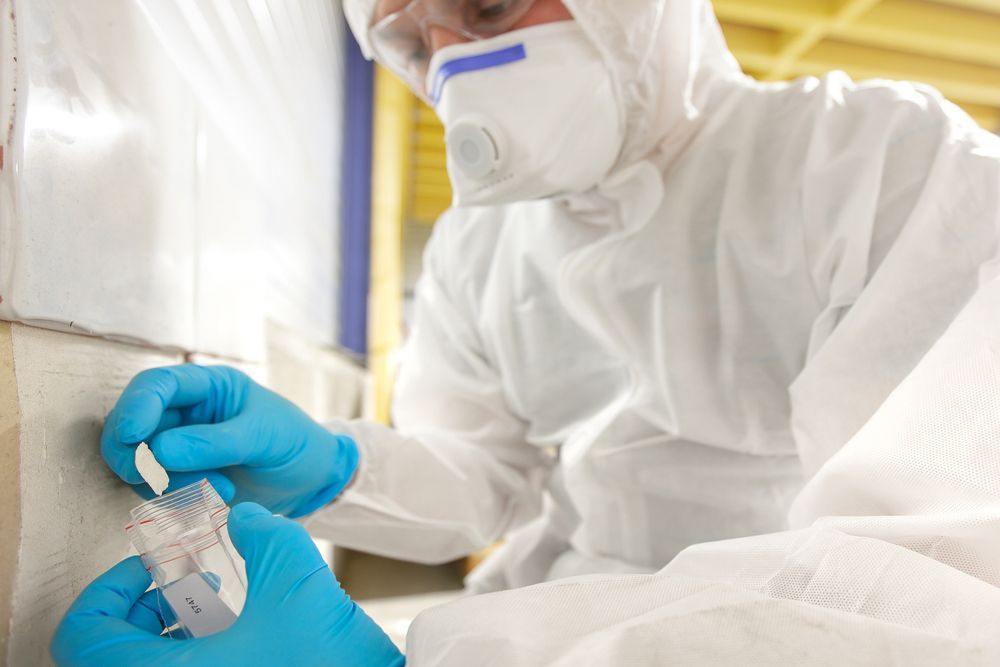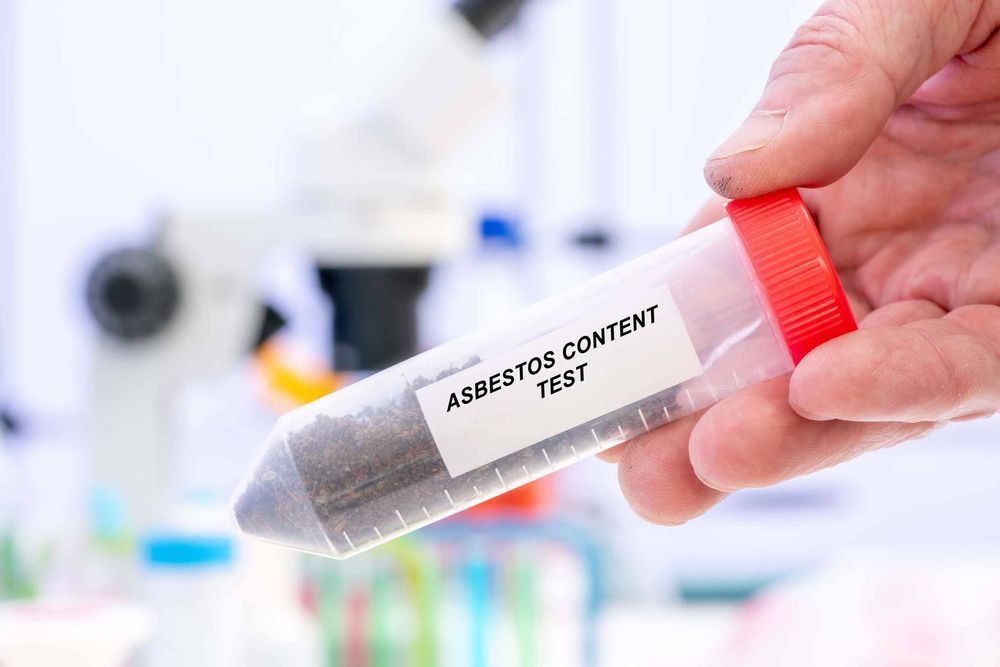Asbestos
Our Certified Asbestos Experts & Services
Envirotest Provides Certified Asbestos Inspectors, Project Monitors, Management Planners and Project Designers
Asbestos testing consists of taking samples in accordance with Federal, State and local authority from a building and performing bulk sample testing by a certified laboratory.
Why Is Asbestos a Hazard?
Asbestos is made up of microscopic bundles of fibers that may become airborne when distributed. These fibers get into the air and may become inhaled into the lungs, where they may cause significant health problems. Researchers still have not determined a "safe level" of exposure but we know the greater and the longer the exposure, the greater the risk of contracting an asbestos related disease. Some of these health problems include:
Asbestosis
A lung disease first found in naval shipyard workers. As asbestos fibers are inhaled, they may become trapped in the lung tissue. The body tries to dissolve the fibers by producing an acid. This acid, due to the chemical resistance of the fiber, does little to damage the fiber, but may scar the surrounding tissue. Eventually, this scarring may become so severe that the lungs cannot function. The latency period (meaning the time it takes for the disease to become developed) is often 25-40 years.
Mesothelioma
A cancer of the pleura (the outer lining of the lung and chest cavity) and/ or the peritoneum (the lining of the abdominal wall). This form of cancer is peculiar because the only known cause is from asbestos exposure. The latency period for mesothelioma is often 15-30 years.
Lung Cancer
Caused by asbestos. The effects of lung cancer are often greatly increased by cigarette smoking ( by about 50%). Cancer of the gastrointestinal tract can also be caused by asbestos. The latency period for cancer is often 15-30 years.
Asbestos Do's and Don'ts for The Homeowner
Do's
- Do keep activities to a minimum in any areas having damaged material that may contain asbestos.
- Do take every precaution to avoid damaging asbestos material.
- Do have removal and major repair done by people trained and qualified in handling asbestos. It is highly recommended that sampling and minor repair also be done by asbestos professionals.
Don'ts
- Don't dust, sweep, or vacuum debris that may contain asbestos.
- Don't saw, sand, scrape, or drill holes in asbestos materials.
- Don't use abrasive pads or brushes on power strippers to strip wax from asbestos flooring.
- Never use a power stripper on a dry floor.
- Don't sand or try to level asbestos flooring or its backing. When asbestos flooring needs replacing, install new floor covering over it, if possible.
- Don't track material that could contain asbestos through the house. If you cannot avoid walking through the area, have it cleaned with a wet mop. If the material is from a damaged area, or if a large area must be cleaned, call an asbestos professional.
Asbestos Inspection and Hazard Assessment
In order to determine the location, quantity and condition of any suspect materials containing environmental hazards in a facility, a comprehensive survey must be performed. Inspectors must first visually examine all spaces in the facility. Next, surfaces are tested and samples taken to determine the presence of hazards on the given surface. Once the physical survey is complete, a report is issued which details the location, quantity and condition of each material and also includes initial recommendations and cost estimates for the abatement action.
Project Design & Specifications
Once materials containing hazards have been identified, remedial or maintenance strategies can then become activated. Project specifications for abatement are developed based on the potential for disturbance, condition of material and other client needs. Project-specific design and abatement specifications prepared by Envirotest ensures our clients that the work is performed in an efficient and effective manner. Elements of the Design/Specification process include:
- Prioritization of material for abatement
- Abatement specifications
- Project drawings
- Bid documents
- Project phasing and scheduling
Project Monitoring and Sampling
Envirotest can provide on-site personnel to monitor contractor activities and collect samples during each phase of the abatement project. Air samples are collected continuously in and around the work area to determine current asbestos concentrations. Contractor compliance and progress are noted for each work shift on daily log sheets for further documentation of the project. Once the abatement is complete, Envirotest visually inspects the work area for any remaining hazard. Samples of representative areas can then be collected and analyzed to confirm the work area status.
Project Management
An experienced Project Manager is assigned to each project and is involved in every step of the abatement process. The purpose of the Project Manager is to assist the client in any manner possible to ensure an efficient and effectively managed abatement project. The Project Manager also makes visits to the site to assist in solving problems or conflicts that may arise, conducts project progress meetings, coordinates all necessary paperwork, manages correspondence and provides guidance and supervision relevant to the overall project.
Technical Report
Once the abatement is complete, Envirotest will organize the necessary project data and issue a technical report. The final report is the last step in ensuring completion of a well-documented abatement project. The final report includes information pertaining to each step of the abatement project. The report also includes copies of the original field and laboratory data to complete the project documentation.
Frequently Asked Questions About Asbestos
What Is Asbestos?
Asbestos is a group of naturally occurring minerals. The three most common types of asbestos are:
- Chrysotile
- Amosite
- Crocidolite
Asbestos is commonly used as an acoustic insulator, thermal insulator, fire proofing and in other building materials. Asbestos fibers are incredibly strong and have properties that make them resistant to heat. Asbestos is often found in ceiling tiles, pipe and vessel insulation, blow onto structural beams and ceilings, in floor tile, linoleum and mastic.
Why Is Asbestos a Hazard?
Asbestos is made up of microscopic bundles of fibers that may become airborne when distributed. These fibers get into the air and may become inhaled into the lungs, where they may cause significant health problems. Researchers still have not determined a "safe level" of exposure but we know the grater and the longer the exposure, the greater the risk of contracting an asbestos related disease. Some of these health problems include:
- Asbestosis - a lung disease first found in navel shipyard workers. As asbestos fibers are inhaled, they may become trapped in the lung tissue. The body tries to dissolve the fibers by producing an acid. This acid, due to the chemical resistance of the fiber, does little to damager the fiber, but may scar the surrounding tissue. Eventually, this scarring may become so severe that the lungs cannot function. The latency period (meaning the time it takes for the disease to become developed) is often 25-40 years.
- Mesothelioma - a cancer of the pleura (the outer lining of the lung) and/or the peritoneum (the lining of the abdominal wall). This form of cancer is peculiar because the only know cause is from asbestos exposure. The latency period for mesothelioma is often 15-30 years.
- Cancer - cause by asbestos. The effects of lung cancer are often greatly increased by cigarette smoking (by about 50%). Cancer of the gastrointestinal tract can also be cause by asbestos. The latency period for cancer is often 15-30 years. Despite the common misconception, asbestos does not cause head-aches, sore muscles or other immediate symptoms. As mentioned above, the effects often go unnoticed for 15-40 years.
When Is Asbestos a Hazard?
Asbestos is not always an immediate hazard. If fact, if asbestos can be maintained in good condition, it is recommended that it be left alone and periodic surveillance performed to monitor its condition. It's only when asbestos containing materials are disturbed or the materials become damaged that it becomes a hazard. When the materials become damaged, the fibers separate and may then become airborne. In the asbestos industry, the term 'friable' is used to describe asbestos that can be reduced to dust by hand pressure. 'Non-friable' means asbestos that is too hard to be reduced to dust by hand. Non-friable materials, such as transite siding and floor tiles are not regulated by the State provided it does not become friable. Machine grinding, sanding and dry-buffing are ways of causing non-friable materials to become friable.
How Are Asbestos Containing Materials Maintained?
Friable asbestos can be maintained in place utilizing several techniques. Encapsulation involves applying a thick layer of an encapsulant, much like latex paint, that binds the surface of the material together and prevents encapsulation and routine monitoring are not enough to prevent damage. When damage occurs, removal may be the best option.
When Is It Necessary to Remove Asbestos Containing Materials?
There is no law that says asbestos has to be removed. It is only when the material can no longer be maintained in good condition and/or the airborne concentrations of asbestos are measured to be too high, or when the building is to be demolished or renovated, that a removal may become the only option. In most states, asbestos may only be removed by Licensed Asbestos Abatement Contractors, utilizing Licensed Workers and Supervisors. Many states are stringent in regulating the removal of asbestos containing materials and all projects are usually inspected by inspectors from the State Department of Labor and Workforce Development a minimum of three times (Most state regulations, however, do not apply to private residences or multi-family residences of less than 4 units or any Federal Property.)
When Is It Required to Have a Building Inspection or Survey?
There are new federal regulations that require all material that has not been tested to be presumed to contain asbestos. Only inspection and sampling may rebut the required presumption. Any builder owner who is renovating or demolishing a building is required by Federal law to have their buildings surveyed for asbestos containing materials. Buildings are not permitted to be demolished if there is asbestos present. Also, public and private schools, K-12, are required by AHERA, the Asbestos Hazard Emergency Response Act, to be inspected and have a management plan prepared, which is to be maintained and available for public inspection.
How Is Asbestos Removed?
When removal is conducted, a licensed contractor must notify the State Department of Labor and Workforce Development and either the City County Health Department or the State Department of Environmental Quality then days in advance of removal. Upon approval from the DLWD, workers construct a containment, sealing all possible entries and exits to prevent air from escaping from containment. Containments are maintained under negative pressure and the air is exhausted through special filters that make sure the air exhausted is safe. A decontamination unit is built onto the containment, where workers change into disposable suits and respirators upon entering, and shower out before exiting the work area, so as not to contaminate the area around the containment by tracking out asbestos on their clothes or body. Once the containment is approved by the DLWD, the contractor wets down the material, which helps reduce the airborne fiber count. As the material is wetted, it is scraped from the surfaces and collected in specially labeled disposal bags. When a bag is full, it is sealed well, wiped down and placed into a second bag, which is also sealed. The bags are placed in a load-out chamber to await transfer to a specially lined waste trailer. When all the visible material is removed and bagged, the bags are loaded out to the waste trailer and the DLWD performs another inspection. (In progress inspections are performed through-out the removal project.) When the DLWD Inspector is satisfied with the cleanliness of the containment, the contractor sprays the entire area with a 'lock-down', which seals any remaining fibers, those that are not visible, to the poly. After the clearance monitoring is conducted and the air counts are within the accepted levels, only then is the containment removed and the remaining poly is bagged and disposed of as contaminated waste. Other abatement techniques, such as removal of pipe insulation via a glove-bag or a mini-containment, are also conducted following procedures outlined by the state Department of Labor and Workforce Deveopment's rules for the Abatement of Friable Materials.
Where Does Asbestos Go After It Is Removed?
After removal, the sealed bags are transported by a Licensed Abatement Contractor or a Licensed Asbestos Hauler, to an EPA Approved Landfill, where it is buried. Disposal manifests are required to be sent to DLWD at the end of each project to ensure the waste arrived at the landfill as required. Anyone hauling asbestos in most states are required to be Licensed as an Abatement Contractor and carry Environmental Impairment insurance to the total of One Million Dollars. Under the authority of the EPA, the state Department of Environmental Quality regulates landfills and maintains a list of landfills approved to take asbestos containing waste.
How Can I Tell if I Have Asbestos in My Building?
The only way to tell if a building material contains asbestos is to contact a certified laboratory who can send a Licensed Inspector to take bulk samples. These samples are taken back to the lab, where they are analyzed under the microscope to determine the content. New OSHA regulations require building owners to presume that any suspect material is asbestos until a laboratory analysis is conducted. Any material that contains less than one percent asbestos is considered non-regulated.
Who Do I Call if I Have a Concern?
Envirotest can answer many questions, please feel free to call us at any time at (781) 329-1133 and we will be able to answer most of you questions. The public may contact the state Department of Labor and Workforce Development concerning any possible asbestos problems, or to obtain a copy of the rules, licensed contractors list or to become a licensed contractor. Call your state's Asbestos Division for these requests or to obtain a worker's, supervisor's, inspector's, management planner's or project designer's license. The state Department of Environmental Quality should also be contacted concerning renovation or demolition permits and NESHAPS enforcement.




